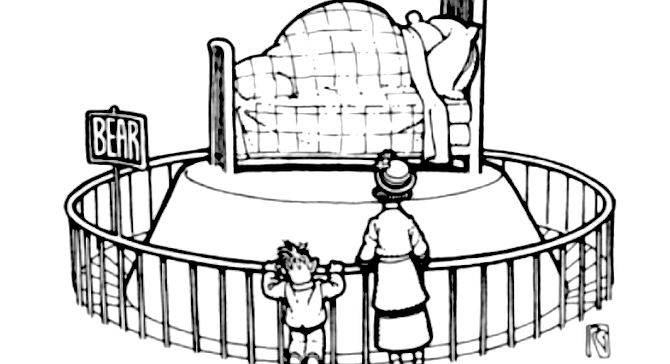 Facebook
Facebook
 X
X
 Instagram
Instagram
 TikTok
TikTok
 Youtube
Youtube

Dear Matthew Alice: What do animals that normally hibernate (like bears) do in a zoo situation? They always seem lively, year ’round. — Waltz + Mims, San Diego
Think about it this way. If you have a comfortable pad, plenty of good chow slung at you every day, and soothing, subtropical temperatures outside, would you dig a cave, crawl in, and sleep? Heck, no. Well, neither would zoo bears. They’re lively year ’round because the environmental triggers for hibernation (temperatures below 32 degrees F., diminished vegetation for food) aren’t there, so they just keep truckin’. San Diego’s zoo has five species of bears, three of which are warm-climate animals that don’t hibernate anyway: sun bears, sloth bears, and spectacled bears. Polar bears are pure carnivores, so they have no need to hibernate; in the wild, they only use winter dens for shelter during the most severe weather.
The one exception to the up-all-winter lifestyle of zoo bears is a pregnant female. Bears give birth in winter, and even without other environmental cues, females instinctively retire to a cubbing den and enter a state of suspended animation for several months.
Until recently there have been many scientific fistfights over whether bears in the wild are true hibernators, but apparently the dispute’s now settled. Among the species that have been studied (very carefully, I would imagine), their heartbeats slow to half normal rate, blood temperatures drop a whole degree, and they do not eat, drink, defecate, or urinate for upwards of four months. They require half the normal amount of oxygen. As one scientific tome puts it, “(B]y their physical signs it seems they are closer to death than life during that time.”


Dear Matthew Alice: What do animals that normally hibernate (like bears) do in a zoo situation? They always seem lively, year ’round. — Waltz + Mims, San Diego
Think about it this way. If you have a comfortable pad, plenty of good chow slung at you every day, and soothing, subtropical temperatures outside, would you dig a cave, crawl in, and sleep? Heck, no. Well, neither would zoo bears. They’re lively year ’round because the environmental triggers for hibernation (temperatures below 32 degrees F., diminished vegetation for food) aren’t there, so they just keep truckin’. San Diego’s zoo has five species of bears, three of which are warm-climate animals that don’t hibernate anyway: sun bears, sloth bears, and spectacled bears. Polar bears are pure carnivores, so they have no need to hibernate; in the wild, they only use winter dens for shelter during the most severe weather.
The one exception to the up-all-winter lifestyle of zoo bears is a pregnant female. Bears give birth in winter, and even without other environmental cues, females instinctively retire to a cubbing den and enter a state of suspended animation for several months.
Until recently there have been many scientific fistfights over whether bears in the wild are true hibernators, but apparently the dispute’s now settled. Among the species that have been studied (very carefully, I would imagine), their heartbeats slow to half normal rate, blood temperatures drop a whole degree, and they do not eat, drink, defecate, or urinate for upwards of four months. They require half the normal amount of oxygen. As one scientific tome puts it, “(B]y their physical signs it seems they are closer to death than life during that time.”
Comments